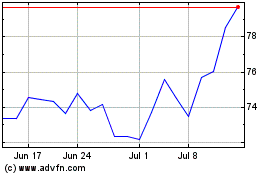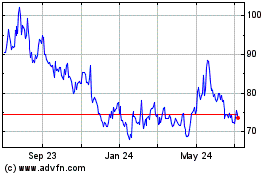By Newley Purnell
NEW DELHI--The leading player in the battle for mobile payments
in India isn't either of China's pioneers, Alibaba Group Holding
Ltd. or Tencent Holdings Ltd. It isn't Apple Inc., Visa Inc. or
even PayPal Holdings Inc. It's Google.
The Alphabet Inc. unit has for years tried to diversify its
revenues beyond advertising by pushing into new fields like cloud
computing and hardware. While its profits remain healthy, it needs
new ways to make money as the specter of regulation looms at home
and around the globe. Its booming new business in the world's
largest untapped digital market could be the engine of expansion
that it has been looking for.
In India today, the company has one of its fastest-growing hits
ever with Google Pay, a two-year-old app that millions of consumers
are using to spend and transfer tens of billions of dollars.
Resembling a chat app and available in local languages, Google
Pay was the most downloaded financial technology app world-wide
last year, according to SensorTower, a research and marketing firm
for the app industry.
Indian consumers use it to buy train tickets, pay bills and can
even purchase lunchtime meals from street vendors. Tiny mom-and-pop
shops around the country now display a logo with a large "G" and
Google's blue, red, yellow and green colors, signaling that
merchants accept payments via the app.
"There's good reason for Google being bullish," said Satish
Meena, a New Delhi-based analyst with research firm Forrester.
"They're getting good traction. The opportunity in India is
massive."
The app has been downloaded more than 180 million times since it
launched in September 2017 and in the first half of this year, it
clocked more downloads world-wide than PayPal or its Venmo app. It
also outpaced Alipay, from Alibaba affiliate Ant Financial Services
Group, data from SensorTower showed.
"India is setting the global standard on how to digitize
payments," Caesar Sengupta, Google's vice president for its Next
Billion Users initiative and payments, said Thursday at an event in
New Delhi. In the past year, the service has processed transactions
worth more than $110 billion on an annualized basis via the
government's popular real-time payments platform, he said.
Analysts estimate Google Pay is now used as much as or more than
any other service, including apps backed by Tencent and Paytm,
which counts among its investors Warren Buffett's Berkshire
Hathaway Inc., SoftBank Group Corp. and Alibaba.
Google offers other payment systems branded Google Pay around
the world, but Google Pay in India is the only service of its kind
offering real-time payments without the use of credit or debit
cards between individuals and businesses.
Shop owners can display a printed QR code for shoppers to scan,
or two individuals can open the app, hold their phones together and
use audio pairing to connect and make payments.
Hundreds of millions of Indians are entering the digital economy
for the first time thanks to inexpensive mobile data and
smartphones. Cash still rules, but most Indians have bank accounts
and for simple payments they are skipping plastic and going
straight to mobile.
The catalyst for mobile-payment growth came in 2016, when
India's government nullified the largest-denomination cash notes in
circulation to curb corruption. That triggered a crunch and
consumers had to stand in long lines for ATMs. Many downloaded
mobile wallets like Paytm's, learned more about digital payments
and became comfortable making them.
Google, sensing an opportunity to get a digital payments
foothold in the country of 1.3 billion, has used its massive war
chest to capture users with an advertising blitz and cash
awards.
The value of mobile payments in India is well behind China's,
but is ahead of the U.S. The value of mobile payments could nearly
double to hit $450 billion a year by 2023, according to a 2018
report from Morgan Stanley, with Google wringing as much as $4.5
billion annually out of the business should it introduce
advertising or other new services.
Google has an early lead but isn't without challenges. The
biggest one on the horizon is Facebook's WhatsApp. The platform has
400 million users in India, more than any other country, and it
rolled out a trial payments service to a million users in February
2018.
Two months later, the Reserve Bank of India said payment-related
data needed to be stored in the country and a complete rollout of
the service has stalled. WhatsApp says it adheres to those rules
and hopes to be able to fully launch the service to all users in
India in the coming months.
Analysts say that Google, having fully launched Google Pay
before the guidelines were issued, hasn't been affected. A Google
spokesman didn't immediately respond to a request for comment on
Google Pay's adherence to data localization guidelines.
"One year ago no one knew about this app," said Surender Singh,
a sales clerk in a New Delhi smartphone shop.
While customers still use rival apps, Google Pay's usage is
surging more than others, with nine or 10 people a day using it at
his shop to buy items like chargers and headsets, spending as much
as $40 per transfer, he said.
"If people don't have credit cards or cash, they use Google
Pay," said Mr. Singh.
Write to Newley Purnell at newley.purnell@wsj.com
(END) Dow Jones Newswires
September 19, 2019 05:44 ET (09:44 GMT)
Copyright (c) 2019 Dow Jones & Company, Inc.
Alibaba (NYSE:BABA)
Historical Stock Chart
From Mar 2024 to Apr 2024

Alibaba (NYSE:BABA)
Historical Stock Chart
From Apr 2023 to Apr 2024
